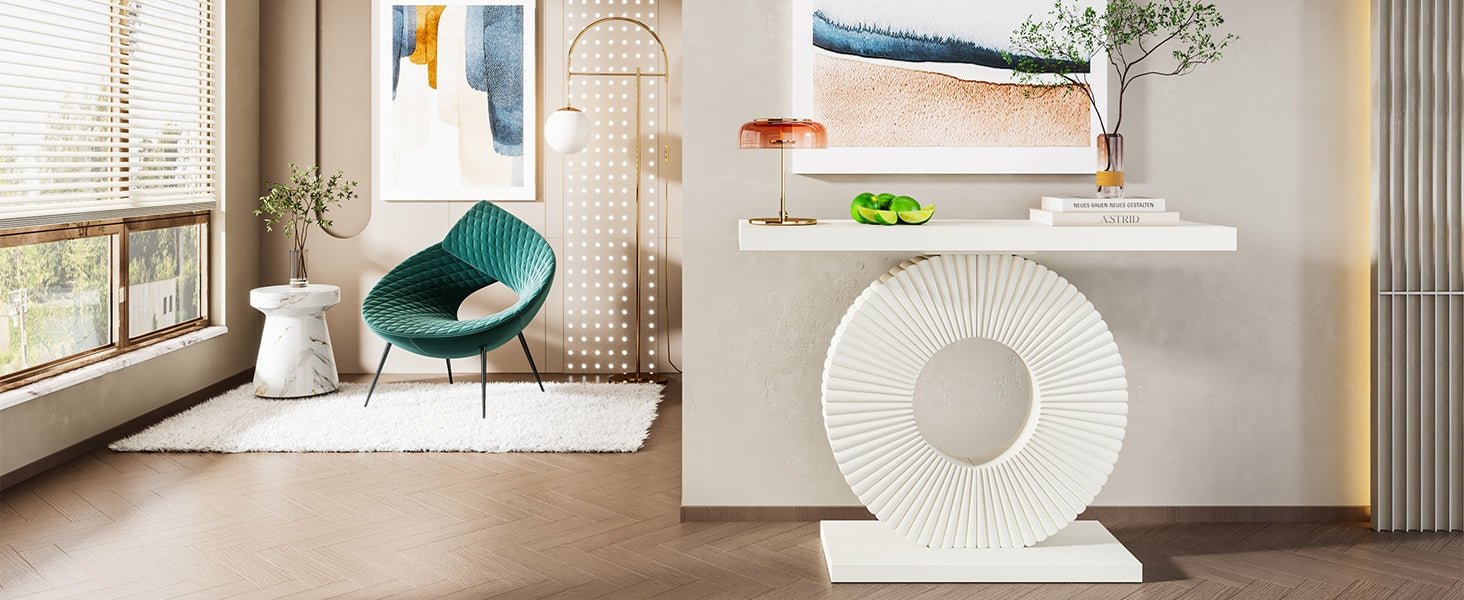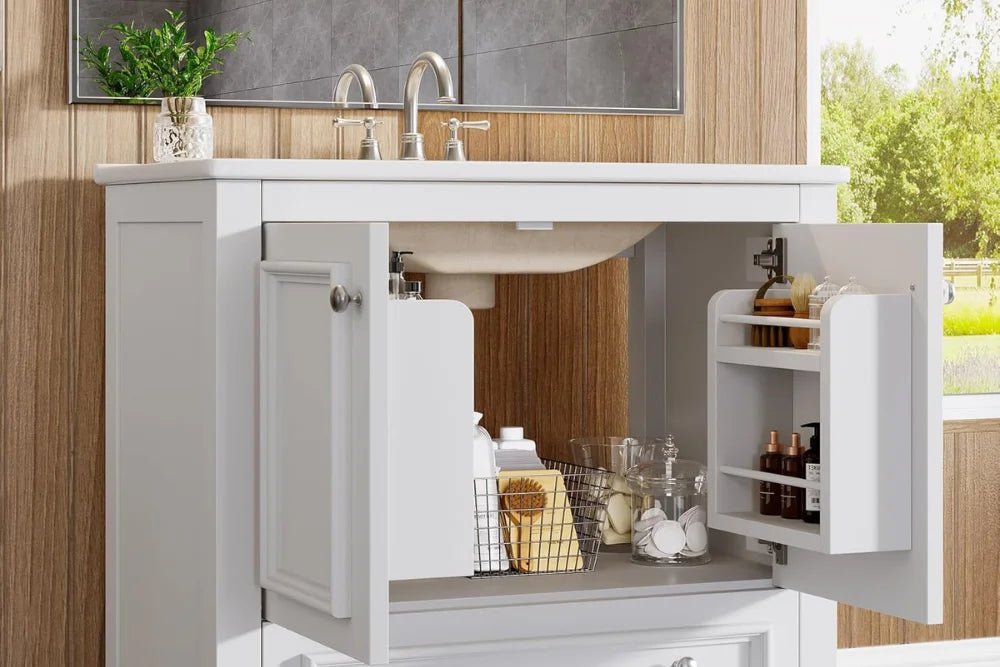Your coffee table is more than just a surface for drinks and magazines; it's a central anchor in your living room, bringing together your seating arrangement and defining the space. But often, homeowners overlook a crucial element that impacts both aesthetics and functionality: its height. A coffee table that's too tall or too short can disrupt the harmony of your room and make it uncomfortable to use.
At Tribesigns, we believe in creating furniture that perfectly blends style, quality, and practicality. In this comprehensive guide, we'll dive deep into the ideal coffee table height, explore what factors to consider when making your selection, and answer some of the most common questions to help you find the perfect centerpiece for your living space.
Table of Contents
Finding the Perfect Coffee Table Height
When it comes to coffee table height, there's a golden rule that designers often follow to ensure both comfort and visual balance:

Align with Sofa Cushions
Ideally, your coffee table should be the same height as your sofa cushions or 1-2 inches shorter. This sweet spot ensures easy reach for drinks, snacks, or remote controls without excessive leaning or stretching. It creates a natural, comfortable flow, making your living room more inviting and functional. If it's too high, it can feel like a barrier; too low, and it becomes an inconvenient stretch.
Standard Height Range
Most coffee tables on the market, including many versatile Tribesigns designs, fall within the range of 14 to 20 inches high. While this offers a good spectrum, the most common and universally complementary heights are typically between 16 to 18 inches. This range has proven to be the most ergonomic for average sofa heights and user comfort.
Consider Sofa Seat Height
Your sofa's seat height is the primary determinant for your coffee table's ideal height. Most sofas have seat heights between 17 and 19 inches. Therefore, a coffee table in the 16 to 18 inch range beautifully complements these standard sofa heights, creating a harmonious and functional arrangement. Always measure your sofa's seat height from the floor to the top of the cushion before you shop!
Read more: Standard Sofa Size Guide
What to Consider When Choosing a Coffee Table?
While height is crucial, several other factors contribute to selecting the perfect coffee table for your Tribesigns-inspired living space.

Measure Existing Living Room Furniture
Before you even start browsing, grab a tape measure. Note down the height, width, and depth of your sofa, accent chairs, and any other prominent furniture pieces. This will give you a clear framework for what dimensions will best fit your space and complement existing items.
Map Out Coffee Table Width & Placement
A common design guideline is to choose a coffee table that is two-thirds the length of your sofa. This proportion ensures it doesn't look too small or overwhelmingly large. Also, consider the "walkway" space: generally, aim for 14 to 18 inches of clearance between your coffee table and the edge of your sofa to allow for comfortable movement.
Coffee Table Height, Width and Length
Height (as discussed above): Aim for sofa cushion height or 1-2 inches shorter.
Width & Length: As mentioned, the length should ideally be about two-thirds of your sofa's length. The width will then follow, ensuring it's proportionate to the length and doesn't overcrowd the room. Consider how much surface area you truly need for daily use.
Consider the Best Coffee Table Length: The Two-Thirds Rule. For example, a 90-inch sofa would pair well with a 60-inch long coffee table.
Think About Shape
The shape of your coffee table can dramatically influence the flow and feel of your room.
- Rectangular or Oval: Classic and versatile, ideal for longer sofas and rooms, offering ample surface area. Great for traditional and transitional styles. Oval shape is also great for a small room.
- Square: Works well with sectional sofas or L-shaped arrangements, creating a more cohesive central point.
- Round Coffee Table: Excellent for softening a room with many straight lines, safer for homes with children (no sharp corners), and promotes easier movement around the table.
- Abstract/Irregular: Can serve as a sculptural art piece, best in minimalist or eclectic spaces.
Material
The material not only dictates the look but also the durability and maintenance. Tribesigns offers a variety of high-quality materials to suit diverse tastes and needs.
- Wood: Timeless, warm, versatile. Options include solid wood (like acacia, oak) for durability or engineered wood with beautiful veneers for affordability and stability.
- Metal: Adds an industrial, modern, or sleek touch. Common options include steel, iron, or brass.
- Glass: Creates an open, airy feel, making small spaces appear larger. Requires frequent cleaning.
- Marble/Stone: Luxurious and durable, but heavy and can be costly. Adds a high-end touch.
- Mixed Materials: A popular choice for a contemporary look, combining elements like wood and metal (Tribesigns style!).
Style of Design
Your coffee table should complement your existing decor and personal style.
- Modern/Minimalist: Clean lines, often metal, glass, or light wood.
- Industrial: Features raw materials like distressed wood and black metal.
- Farmhouse/Rustic: Reclaimed wood, distressed finishes, sturdy build.
- Bohemian: Often incorporates natural textures, intricate carvings, or woven elements.
- Traditional: Ornate details, darker woods, classic shapes.
- Contemporary: Mixes modern and traditional elements, focusing on current trends.

FAQ
What is the Standard Height of a Coffee Table?
Most coffee tables are between 14 and 20 inches high, with the most common and versatile range being 16 to 18 inches.
How High Should a Coffee Table Be Off the Ground?
The overall height of a coffee table from the ground will depend on its design. Whether it's on slender legs, a solid plinth base, or has integrated storage, the critical measurement remains its total height relative to your sofa's seat cushion – ideally, the same height or 1-2 inches shorter.
How Many Inches Should a Coffee Table Be Away From a Couch?
Generally, a coffee table should be about 14 to 18 inches (35-45 cm) away from a couch. This distance allows for comfortable legroom and easy access to items on the table.
Can My Coffee Table be Higher Than The Sofa?
While it's not ideal for comfort or aesthetics, a coffee table can technically be slightly higher than the sofa, especially if it's designed to be a multi-functional piece for dining or working. However, for a traditional living room setup, it's generally advised to keep the coffee table at or slightly below sofa cushion height for optimal comfort and visual flow.
What Type of Coffee Table Goes With a Grey Sofa?
- Warm Wood Tones: For a cozy, inviting look (e.g., Tribesigns rustic brown or natural wood finishes).
- Black Metal/Industrial: For a modern, edgy contrast.
- Glass/Acrylic: For a light, airy, and contemporary feel.
- White/Light-colored Materials: For a bright, minimalist, or Scandinavian aesthetic.
Conclusion
Choosing the right coffee table height is a subtle yet significant detail that can transform your living room's comfort and visual appeal. By keeping your sofa's height in mind, considering the dimensions of your space, and exploring the diverse styles and materials available from Tribesigns, you're well on your way to selecting a coffee table that's not just functional but truly elevates your home.
Ready to find your perfect match? Explore Tribesigns' wide selection of stylish and practical coffee tables designed for the modern American home, offering solutions for every style and need.



